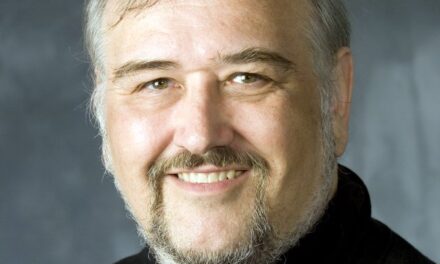Il Trovatore (The Troubadour) was the seventeenth opera composed by Giuseppe Verdi (1813-1901). The four-act opera is set to a text by Salvatore Cammarano after the Spanish play El Trovador by Leone Emanuele Bardare. That handy reference, The New Kobbé’s Complete Opera Book (1976), describes it as having world-wide popularity for many years while its libretto has long been considered “the acme of absurdity.” Verdi’s “swift, spontaneous, and stirring music” sweeps all the libretto’s absurdities before it. The biggest drag on the plot’s reality is the fact that so much of the story is supposed to have taken place before the curtain rises.
Enrico Caruso reportedly said that all Il Trovatore needs to succeed is four of the greatest singers in the world. This, wedded to Verdi’s dynamic and searing score, will sweep over reservations about the ridiculous libretto and the opera’s unjustified length. Virginia Opera‘s music director Peter Mark’s powerful and vocally solid cast, combined with his choice of stage director Lillian Groag, made the strongest possible case for this flawed gem of the composer’s maturity. In the pit of Richmond’s Landmark Theater, members of the Virginia Symphony were instantly responsive to Mark’s expressive and tightly controlled interpretation. The balances between stage and orchestra were splendid, as was the musical co-ordination. There were fine solos from the clarinet and horn. Special kudos should be given to the four percussionists who hammered away on the one anvil on stage in Act II.
I caught part of dramatic soprano Eilana Lappalainen’s vocal warm up in the huge assembly room under the auditorium, and I was astonished at the sheer sustained power she could wield. As the tormented Leonora, the Finnish-Canadian singer easily filled Landmark Theater’s large auditorium, and her high notes, hit precisely, were spectacular. Her refined, quiet singing was just as impressive. Her Manrico, tenor Gustavo López Manzitti, matched her in vocal heft. He nailed his high notes and his solidly supported voice was a model of good vocal training. His vocal capital has been carefully husbanded and is spent wisely. In his fiery Act III aria, “Di quella pira” (“See the pyre blazing”), he delivered the goods, an exhilarating high C near its end. According to Julian Budden, writing in volume II of The Operas of Verdi, this interpolated note was originated by the tenor Achille Tamberlick, and Verdi countenanced it only if it (the high note) was “a good one.” Manzitti’s winning tone has a nice Italianate ring. Baritone Nmon Ford was a powerful, threatening Count Di Luna. He had plenty of weight in his dark, rich toned voice, along with plenty of stage presence, allowing him to dominate the stage or hold his own with his Leonora and Manrico. Besides conveying the Count’s jealously and rage, Ford’s refined control of his dynamics and timbre allowed him to fully bring out the few tender emotions Verdi gave his character. It was a pleasure to see his return to Virginia Opera where we had enjoyed his strongly sung Kurneval in Wagner’s Tristan und Isolde. (We heard him also in the Spoleto Festival USA’s controversial 2005 staging of Mozart’s Don Giovanni.) Mezzo-soprano Jeniece Golbourne had a firm, sumptuous lower range for the revenge-obsessed gypsy, Azucena. Her soaring, firmly supported high notes were a pleasant surprise.
The secondary role of Ferrando, Di Luna’s captain of the guard, is one of the biggest “minor roles” in opera. His extended Act I ballad gives essential background for the tragedy and his Act III recognition of Azucena is nearly as crucial. Egyptian-born and US-trained bass-baritone Ashraf Sewailam was superb in this role, his attractive, dark and sepulchral tone easily standing out in ensembles and giving dramatic weight to his important scenes. Tenor James Taylor was fine as one of Manrico’s soldiers, Ruiz. Solid performances were given by soprano Kirsten Hoiseth as Leonora’s confidant Inez, baritone Kevin Wetzel as a gypsy, and tenor Johnny Lee Green as a messenger. The chorus, prepared by Joseph Walsh, was up to their usual high standard as they portrayed soldiers, gypsies, and nuns.
In an age abounding in anachronistic staging of opera, director Lillian Groag’s choice of Verdi’s original time period, 15th century Spain was most welcome. Groag’s original touch was to have various scenes “haunted” by the silent “ghost” of Azucena’s mother. Both military factions had blunt, stubby wrought-iron bombards (though their gun carriages would have not been strong enough for the real McCoy). Michael Ganio’s simple sets featured elements which could be effectively and quickly reconfigured to suggest palace atrium, gypsy camp, cloister, chapel, and prison in turn. Richard Winkler’s lighting design was imaginative and outstanding.
This season’s staging of Il Trovatore was a milestone in the 34 season history of the Virginia Opera Company, marking Artistic Director Peter Mark’s 100th production.













